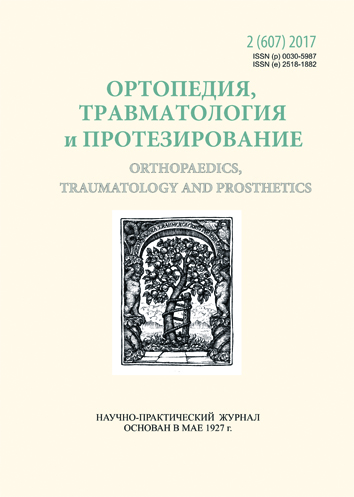Weight-bear specifics in patients with post traumatic extraarticular femoral and tibial fractures (statographic research)
DOI:
https://doi.org/10.15674/0030-59872017235-44Keywords:
deformation, femur, tibia, statographyAbstract
An important component in the result of treatment of patients with posttraumatic deformities is the restoration of the wight-bearing ability of the damaged limb.
Objective: to study the features of the wight-bearing ability patients with posttraumatic extraarticular deformities of the femur and shin bones according to statography.
Methods: the results of standard statographic examinations were analyzed during a two-legged stance and with predominant support on each of the extremities of 38 patients, among whom 20 revealed bone fracture disorders and tibial deformity, 18 had femoral deformity. The duration of the deformation is from 3 to 15 months.
Results: in patients with tibial deformations in the frontal plane, the common center of mass is shifted toward the intact limb and in patients with femoral deformity toward injured. In the sagittal plane, in patients with deformations of the tibia swings of the body in the frontal plane and in femur in the sagittal plane were noted. In single-bearing standing, patients with tibial deformity relied more on an intact limb and the displacement of the tibia was about 30 mm for both extremities (p < 0.05). In cases of femoral deformation, the difference between the shifts was almost 2 times (p < 0.05). A significant difference (p < 0.05) was found between the values of the scatter of the common center of mass and the scatter asymmetry coefficients in single-bearing standing in patients with deformations of tibia and femur. Reduction of the load on the affected limb was observed in all of the examined subjects. With the help of the analysis of statistical studies, a system was developed for assessing the patient’s initial condition and monitoring the process of his rehabilitation after surgical intervention.
Conclusions: the analysis of the results of a statographic study of patients with extra-articular deformations of the tibia or femur performed prior to reconstructive intervention and in the dynamics after it allows to objectify the changes in the tolerance of the injured limb and to achieve a positive result of the treatment.References
- Engsberg J, Leduc S, Ricci W, Borrelli JrJ. Improved function and joint kinematics after correction of tibial malalignment. Am J Orthop. 2014;43(12):E313–8.
- Marti RK, van Heerwaarden RJ. Osteotomies for posttraumatic deformities. Georg Thieme Verlag, 2008. 704 p.
- Paley D. Principles of deformity correction. 2002. 806 p.
- Romanenko КК, Ashukina NO, Batura IO, Prozorovsky DV. Morphology of the articular cartilage of the knee joint in rats with extraarticular femoral bone deformity. Orthopaedics, Traumatology and Prosthetics. 2017;(1):63–71. doi: 10.15674/0030-59872017163-71. (in Ukrainian)
- Tyazhelov OA, Karpinsky MYu, Karpinska OD, Yaremin SYu. Justification and analysis of geometric parameters of statographic data for evaluation the musculoskeletal system of human. Orthopaedics, Traumatology and Prosthetics. 2014;(3):62–7. doi: 10.15674/0030-59872014362-67. (in Ukrainian)
- Nasledov A. SPSS 19: professional statistical analysis of data. St. Petersburg: Peter, 2011. 400 р. (in Russian)
Downloads
How to Cite
Issue
Section
License
Copyright (c) 2017 Konstantin Romanenko, Yaroslav Doluda, Mykhaylo Karpinsky, Dmytro Prozorovsky

This work is licensed under a Creative Commons Attribution 4.0 International License.
The authors retain the right of authorship of their manuscript and pass the journal the right of the first publication of this article, which automatically become available from the date of publication under the terms of Creative Commons Attribution License, which allows others to freely distribute the published manuscript with mandatory linking to authors of the original research and the first publication of this one in this journal.
Authors have the right to enter into a separate supplemental agreement on the additional non-exclusive distribution of manuscript in the form in which it was published by the journal (i.e. to put work in electronic storage of an institution or publish as a part of the book) while maintaining the reference to the first publication of the manuscript in this journal.
The editorial policy of the journal allows authors and encourages manuscript accommodation online (i.e. in storage of an institution or on the personal websites) as before submission of the manuscript to the editorial office, and during its editorial processing because it contributes to productive scientific discussion and positively affects the efficiency and dynamics of the published manuscript citation (see The Effect of Open Access).














